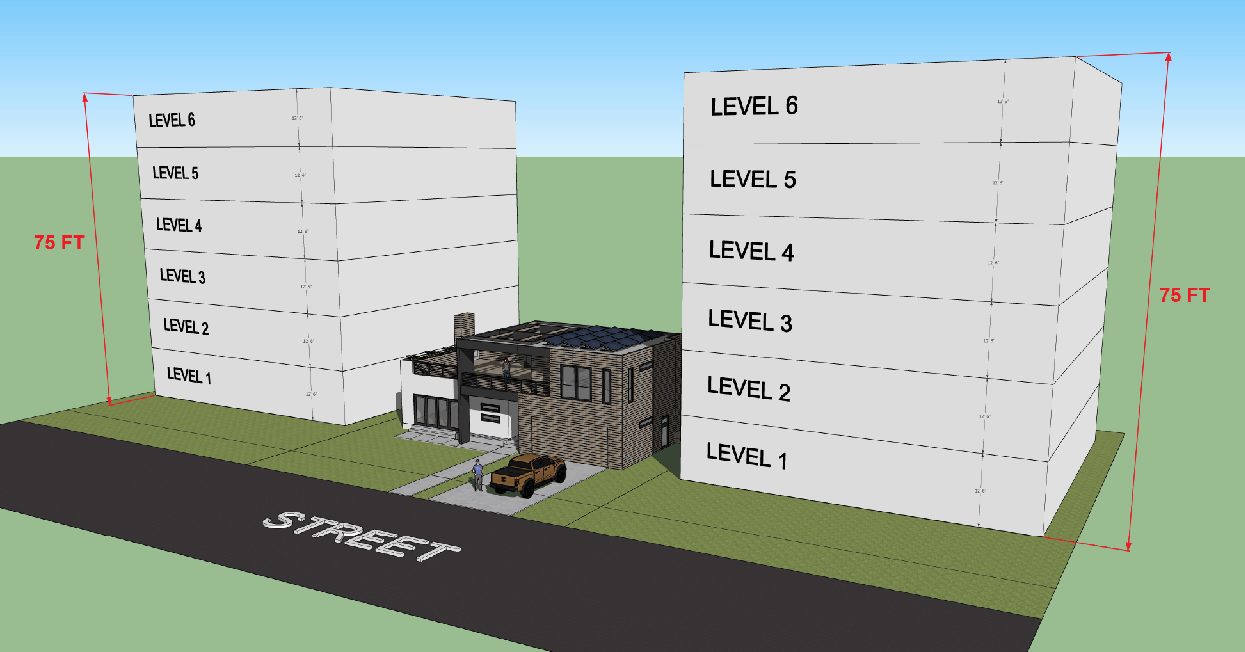7 TALKING POINTS against SB 50 for California City Officials and Community Leaders
SB 50 is an unprecedented taking of local planning powers that hands city and community decision-making directly to luxury housing developers. It provides no help for cities to recover from developers’ disruption of low-income neighborhoods, communities of color and single-family neighborhoods. Instead, SB 50 lavishly rewards developers who aggressively construct housing affordable only to the wealthy, and that includes just a small percentage of affordable units. SB 50 is fatally flawed. It will worsen our affordable housing crisis.
1) “Neighborhood Multi-Family Areas” Single-family zoning would be banned. Developers could buy out your neighbor or entire blocks, erecting lucrative 4-unit market-rate buildings. If a single-family area is dubbed “transit rich” or “jobs-rich,” then multi-story buildings are allowed.
2) “Transit-Rich Areas” Developers could override city zoning near rail stops and frequent bus stops to erect 4-story to 8-story towers — with few affordable units. To boost developer profits while claiming “sustainability,” SB 50 requires no parking in apartment complexes near rail.
3) “Jobs-Rich Areas” Developers can override zoning in jobs-rich/good schools areas that have no transit service, allowing expensive 4-story to 8-story towers with very few affordable units.
4) “Carve-out Counties” Cities in less urban, mostly upscale counties — including Marin, Santa Cruz and Santa Barbara — would not be forced to allow 4- to 8-story towers near transit. Instead they’d be required to allow apartments one story higher than their existing zoning.
5) “10-Unit Exemption” Projects that contain fewer than 11 units get all of SB 50’s profit benefits yet require NO affordable units. UCLA Professor Michal Storper’s stand against SB 50 focuses on this element, in which the State would openly reward 10-unit luxury-only buildings.
6) “Density Bonus Powers” San Francisco planners identified the profit points SB 50 will reward to developers who include a few affordable units in luxury buildings. In practice, developers would control up to six areas of city and community planning, including, but not limited to:
- Setbacks – Developer can SLASH THE BREATHING ROOM cities require for trees, green belts, side yards.
- Floor area ratio – Developer can OVERRIDE CITY SIZE restrictions, adding 47% to 297% to building sizes.
- Parking – Developer can erect big apartment complexes with NO PARKING, OVERRIDING city rules.
- Standards: Developer can OVERRIDE CITY STANDARDS (design/sustainability/safety) that aren’t state law.
- Onsite open-space – Developers can OVERRIDE courtyards and balconies required by cities.
- Historic – Developers can OVERRIDE protection of homes not on the CA Registry of Historic Resources.
7) “Sensitive Communities” This list of still-unidentified communities, deemed to have a high percent of working-class, minority, or poor residents, would be granted 5 years to find a way to upzone their areas to let SB 50 take effect. They would essentially plan for their own demise.
Senate Bill 50 is Propelled by Meaningless Data — and Sacramento Panic
Background:
SB 50 bans single-family zoning in California and disrupts existing and thriving low-income communities. A handful of coastal zones and all severe fire hazard areas are spared, but the state would “upzone” virtually all cities to allow luxury apartments on most residential streets.
State Sen. Scott Wiener of San Francisco, who derides single-family housing as immoral, says developers will thrive from SB 50’s profit incentives, creating a housing boom that will trickle down to those in need. The San Francisco Board of Supervisors, who have seen the luxury boom fail to trickle down in the Bay Area, strongly disagrees. They oppose SB 50, as do many cities.
Prof. Michael Storper of UCLA and London School of Economics calls SB 50 a politicized experiment in “Shock Zoning Therapy” that is based on no proofs, that will clearly drive up land costs, and that will likely fuel painful housing unaffordability and gentrification.
The non-partisan think tank Embarcadero Institute has determined that poorly reasoned state housing bills such as SB 50 are thanks to a false narrative flowing from the highest political levels in Sacramento — that California needs “3.5 million housing units” by 2025.
In fact, as Embarcadero Institute has vividly proved, California’s own internal housing numbers confirm that California needs about 1.2 million housing units by 2025 — not 3.5 million.
SB 50 is driven by panic in the State Legislature set off by bad data — the false 3.5 million housing shortage claim. The 3.5 million number was conjured up in a McKinsey report that used New York as the benchmark for California’s needs, a method that would be marked as “unsatisfactory” in any middle-school social studies class.
This is an important distinction. California cities are moving toward building the actual housing need — 1.2 million new units by 2025. That 1.2 million is achievable through modest and positive change. Unfortunately, the national media and California media have latched onto the false 3.5 million shortage claim, propelling Sacramento toward passing bad panic bills.
SB 50 Tower ScaleSB 50 Tower ScaleSB 50 Tower Scale
L.A. has approved more than 100,000 housing units, with far more to come, without the controlling hand of SB 50. San Francisco has approved more than 70,000 — not acknowledged in Wiener’s false narrative that cities need “Shock Zoning Therapy.” To our knowledge, only the Embarcadero Institute produces consistently accurate reports on housing needs.

